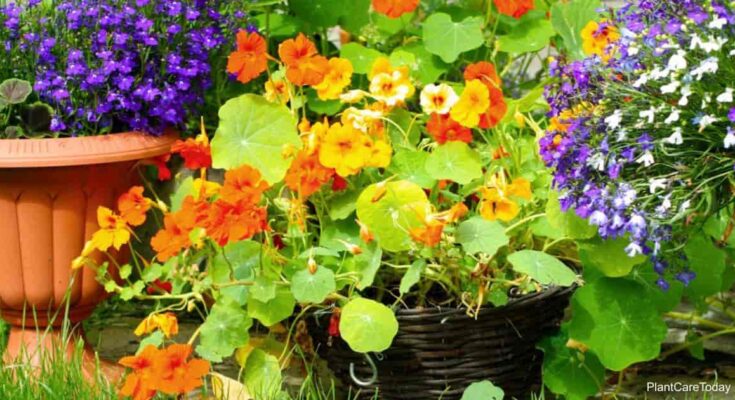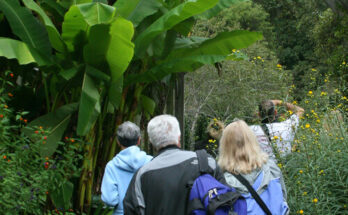Companion planting is the pinnacle of gardening and has much more to do with nature’s inherent ability to protect itself than simple aesthetics.
For example, an issue of Mother Earth News Almanac (an off-the-grid sibling to the Old Farmer’s Almanac) in the 1970s described how you could use companion planting to grow a loaf of bread in a single square acre of land with no pesticides or weeding required.
As crazy as this sounds, companion planting, also referred to as complementary gardening, is something you might have done already without realizing it.
One amazing but an overlooked plant that’s a cornerstone of companion planting is the nasturtium plants.
These plants are beautiful additions to any garden, yet their true beauty is how well they complement other plants.
Let’s take a moment to look at why nasturtium is useful and some of the best plants to grow alongside your nasturtiums in crop and floral garden settings.
What Are The Top Nasturtium Companion Plants?
There are two categories of companion planting: those plants that benefit from other plants and those that provide the benefits.
Nasturtium is among the latter, gaining no real benefits from other plants besides visual appeal but providing a valuable service to other plants.
The Benefits of Growing Nasturtium
Nasturtiums are attractive plants often grown along borders or in window boxes.
They’re somewhat infamous for attracting pests such as aphids, which can be off-putting if you just want to grow them on their own.
However, when grown as a companion plant, this quality makes nasturtiums the perfect sacrificial plant, meaning they’ll draw pests away from your more valuable flowers and crops.
This can greatly reduce the need for chemical insecticides when nasturtium is planted around those plants you wish to protect.
In addition to drawing common piercing insects away from other plants, nasturtiums also repel many nasty bugs, including:
- Cabbage moths and worms
- Carrot flies
- Cucumber beetles
- Flea beetles
- Mexican bean beetles
- Striped pumpkin beetles
- Squash beetles
But there’s another huge benefit to growing nasturtium as a companion plant – it’s edible.
That’s right, and you have a wonderful barrier against pests that can be harvested and eaten.
The leaves are great for salads and contain vitamin C and other nutrients.
Meanwhile, the flowers are edible and have a slight peppery taste, making them great for a snack or as a garnish.
Even the seeds and stems can be eaten, making these plants well worth their keep.
A third benefit is that nasturtiums attract pollinators and natural predators.
Bees, butterflies, hummingbirds, hoverflies, ladybugs, and parasitic wasps will all want to hang around your garden patch when this flower is present.
As a result, you’ll have bigger crop yields from the improved pollination the first three provide while the latter three actively hunt down any insect pests that get past the nasturtiums.
Companion Crops
We’ve just mentioned how nasturtium protects other plants from pests and can be eaten, so it should be no surprise that these plants benefit many food crops.
The cabbage family gains a huge amount of protection from nasturtium.
Common crop plants that your nasturtiums will protect include:
- Apple trees
- Bean
- Broccoli
- Brussels sprout
- Carrot
- Celery
- Cabbage
- Cauliflower
- Cucumber
- Eggplant
- Kale
- Kohlrabi
- Maize
- Melon
- Pepper
- Potato
- Pumpkin (which also has edible flowers, incidentally)
- Radish
- Raspberry
- Sage
- Spinach
- Squash
- Tomato
- Zucchini
Companion plants often release chemicals that can improve growth and flavor in nearby plants, and it’s widely believed that nasturtium is no exception.
However, keep in mind that proximity matters.
For example, planting nasturtium too close to tomatoes can result in bugs crossing over to the latter since tomatoes are a fan favorite of many pest species.
Companion Flowering And Ornamental Plants
The way that nasturtiums trail and snake around other plants has long been a major draw for these plants, making them perfect for borders.
Pair that with their long and relatively late bloom time, and you have an excellent foreground for taller flowers.
Some of the many plants that look great when surrounded by nasturtium include:
- Camella
- Cleome
- Daisy
- Hosta
- Hyssop
- Marigold
- Nicotiana
- Snapdragon
You can even put them on the edges of larger containers, planting geraniums, lamb’s ears, ornamental grass, petunias, or similar plants.
As with crop plants, the nasturtium aid your ornamentals by attracting pollinators while simultaneously completely repelling insect pests.
Best of all, nasturtiums come in a wide range of colors, so you can complement bloom colors or use vibrant blooms to accent a non-flowering ornamental.
You can even set your beds so that the earliest bloomers are in the middle and nasturtium is on the outside to create a season-long ripple of color.
Finally, marigolds and sage are also companion plants, so pairing them with nasturtium can create an even stronger defense against pests.
Source link
Originally posted 2022-08-13 14:39:55.





